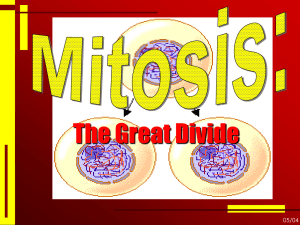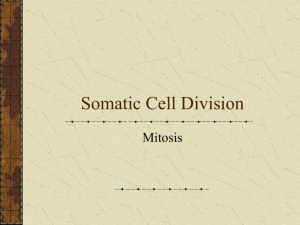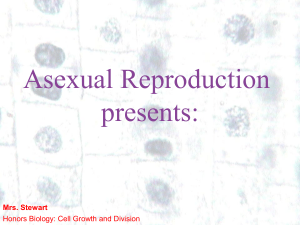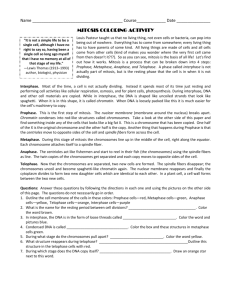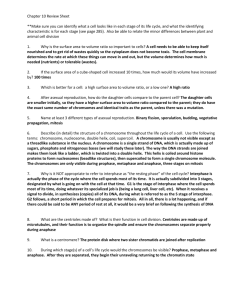Big Idea 3A Basic Review Which of the following bases is not found
advertisement
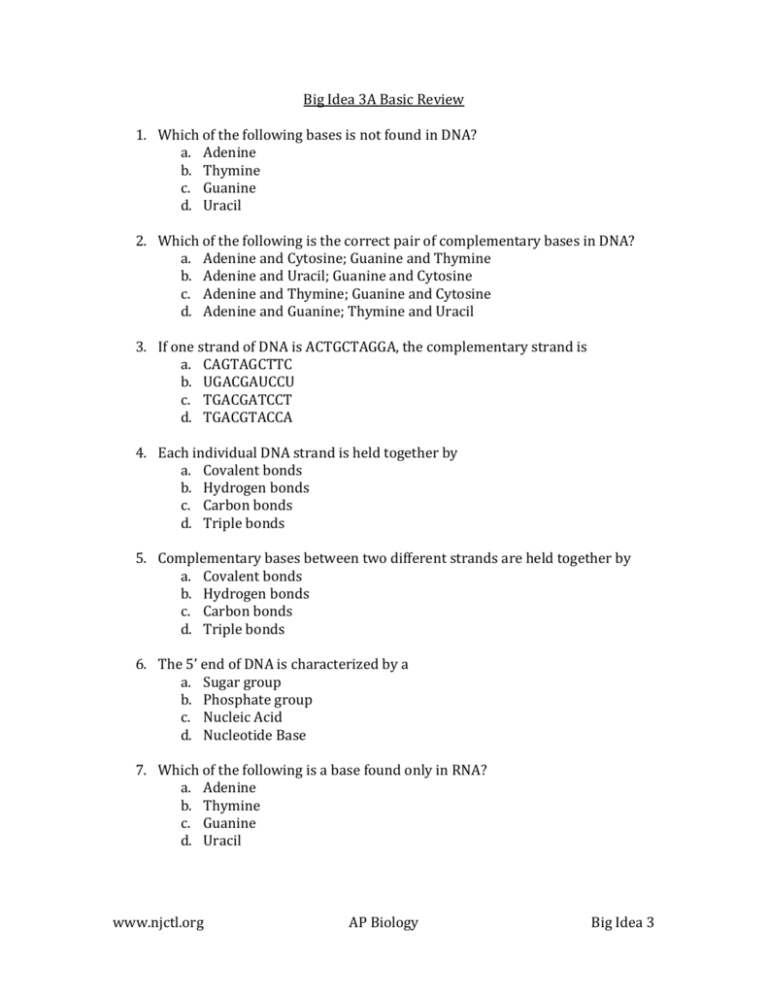
Big Idea 3A Basic Review 1. Which of the following bases is not found in DNA? a. Adenine b. Thymine c. Guanine d. Uracil 2. Which of the following is the correct pair of complementary bases in DNA? a. Adenine and Cytosine; Guanine and Thymine b. Adenine and Uracil; Guanine and Cytosine c. Adenine and Thymine; Guanine and Cytosine d. Adenine and Guanine; Thymine and Uracil 3. If one strand of DNA is ACTGCTAGGA, the complementary strand is a. CAGTAGCTTC b. UGACGAUCCU c. TGACGATCCT d. TGACGTACCA 4. Each individual DNA strand is held together by a. Covalent bonds b. Hydrogen bonds c. Carbon bonds d. Triple bonds 5. Complementary bases between two different strands are held together by a. Covalent bonds b. Hydrogen bonds c. Carbon bonds d. Triple bonds 6. The 5’ end of DNA is characterized by a a. Sugar group b. Phosphate group c. Nucleic Acid d. Nucleotide Base 7. Which of the following is a base found only in RNA? a. Adenine b. Thymine c. Guanine d. Uracil www.njctl.org AP Biology Big Idea 3 8. Which best describes the shape of RNA? a. Double stranded, many different shapes b. Double stranded helix c. Single stranded, many different shapes d. Single stranded helix 9. During DNA replication, a. The parent strand is read in the 3’ to 5’ direction and the daughter strand is synthesized in the 3’ to 5’ direction b. The parent strand is read in the 3’ to 5’ direction and the daughter strand is synthesized in the 5’ to 3’ direction c. The parent strand is read in the 5’ to 3’ direction and the daughter strand is synthesized in the 5’ to 3’ direction d. The parent strand is read in the 5’ to 3’ direction and the daughter strand is synthesized in the 3’ to 5’ direction 10. If the parent strand of DNA is 5’ AACGTGGCAT 3’, which would be the expected daughter strand? a. 5’ TTGCACCGTA 3’ b. 3’ ATGCCACGTT 5’ c. 3’ TTGCACCGTA 5’ d. 5’ ATCGGTCGTT 3’ 11. If the daughter strand of DNA is 5’ CCGTAACTAGG 3’, which would be the expected parent stand? a. 5’ GGCTAAGATCC 3’ b. 3’ GGCTAAGATCC 5’ c. 5’ GGCATTGATCC 3’ d. 3’ GGCATTGATCC 5’ 12. DNA replication is best described as a a. Non-conservative process b. Semi-conservative process c. Conservative process d. Wholly conservative process 13. What is a chromosome? a. A soup-like mixture of nucleic acids and lipids b. Condensed packages of DNA and protein that allow for the division of the genetic material c. A fibrous complex of DNA that facilitates DNA replication d. None of the above www.njctl.org AP Biology Big Idea 3 14. The structures labeled A in the chromosome above are a. Chromosomal bifurcations b. Centrioles c. Sister chromatids d. Chromopores 15. The structure labeled B in the chromosome above is a a. Centriole b. Chromatid c. Centromere d. Chromatin 16. If an organism’s diploid number of chromosomes is 12, its haploid number of chromosomes is a. 6 b. 12 c. 24 d. 48 17. A typical cell spends more than 90% of its life in a. S phase b. Interphase c. Mitotic phase d. Prometaphase 18. Which of the following is not a sub-phase of interphase are a. G1 b. S c. G2 d. prophase 19. Identify the correct pairing a. G1; cell completes growth necessary for division b. S phase; cell duplicates its organelles c. Interphase; cell grows, copies its DNA, and prepares to divide d. G2; cell replicates DNA www.njctl.org AP Biology Big Idea 3 20. During the Synthesis or S-phase a. DNA Replication occurs b. Chromosome number doubles so that by the end of the phase each chromosome consists of two identical sister chromatids c. The cell completes its growth and is ready for division d. Both a and b 21. Why must a cell duplicate its genetic information before splitting in half? a. To ensure each daughter cell has a full set of identical DNA b. To reduce the chance of mutation c. To ensure each cell has double the number of chromosomes the parent cell had d. To ensure each daughter cell has an extra set to pass on when it divides 22. If a cell has 46 chromosomes, how many chromosomes will each of its daughter cells have after mitosis? a. 23 b. 46 c. 92 d. 2n where n=23 23. Although the chromosomes do not become visible until the beginning of the Mitotic phase, it is useful to think of each chromosome as doubling, forming two identical sister chromatids during the S-phase of interphase. However, during the S-phase DNA is actually not condensed, but unpacked into a loose fiber so that replication can occur. This fibrous structure is called a. Chromatin b. Chromosome c. Centromere d. Gelatin 24. During which phase of the cell cycle are gene mutations most likely to occur? a. G1 b. S phase c. G2 d. Mitotic Phase 25. The process of cell division results in? a. Half the number of cells b. Uncontrolled growth c. Mitosis d. Two daughter cells www.njctl.org AP Biology Big Idea 3 26. Why do cells undergo cell division? a. Growth of the organism b. To reproduce asexually c. To repair tissue damage d. All of the above 27. The two main phases of the cell cycle are a. Interphase and mitotic phase b. Mitosis and cytokinesis c. DNA duplication and cell division d. Mitosis and meiosis 28. The two sub-phases of the mitotic phase are a. Mitosis and cytokinesis b. Prophase and metaphase c. Interphase and cytokinesis d. Anaphase and telophase 29. Mitosis specifically refers to which process? a. The division of the cell b. The cell cycle c. The division of the nucleus d. The division of the cytoplasm 30. Which of the following represents the phases of mitosis in proper sequence? a. Prophase, metaphase, anaphase, telophase, and cytokinesis b. Interphase, prophase, anaphase, metaphase, telophase c. Interphase, prophase, metaphase, anaphase, and telophase d. Prophase, prometaphase, metaphase, anaphase, and telophase 31. During prophase a. The mitotic spindle starts to form from the centrosomes b. The nucleus breaks down c. The centrosomes move towards opposite ends of the cell d. All of the above 32. What is the function of the mitotic spindle? a. To divide the cell in half b. To signal cytokinesis c. To provide a scaffold for chromosomes to attach to so they can separate and move to opposite sides of the cell d. To produce centrosomes www.njctl.org AP Biology Big Idea 3 33. What happens during prometaphase? a. Chromosomes attach to the mitotic spindle and the nuclear membrane disappears b. Chromosomes condense c. Chromosomes line up along the metaphase plate d. All of the above 34. What phase of mitosis is shown above? a. Prometaphase b. Metaphase c. Anaphase d. Telophase 35. Sister chromatids separate from the centromere and move apart from each other during which phase of mitosis? a. prophase b. metaphase c. anaphase d. telophase 36. After sister chromatids separate from each other and move to opposite ends of the cell each sister chromatid is referred to as an individual a. Chromatid b. Sister chromatid c. Chromosome d. DNA molecule 37. What happens during telophase a. The cell elongates b. The nuclear envelope reforms around each set of chromosomes c. The chromosomes uncoil d. All of the above 38. Cytokinesis refers to? a. Division of the chromosomes b. Division of the nucleus c. Division of the organelles d. Division of the cytoplasm www.njctl.org AP Biology Big Idea 3 39. How does cytokinesis differ in plant cells and animal cells? a. The process is the same in all eukaryotes b. In animal cells, a cell plate forms between the two nuclei; in plant cells, a cleavage furrow forms and the cytoplasm is “pinched” in half c. In plant cells, a cell plate forms between the two nuclei; in animal cells, a cleavage furrow forms and the cytoplasm is “pinched” in half d. A cell membrane forms around animal cells only 40. Why does the cell have checkpoints at G1, G2, and before mitosis to regulate cell division? a. To prevent mature cells like neurons and muscles from continuing to divide b. To stop unwanted cell growth c. To prevent cells with mutations from producing more cells d. All of the above Answers 1. d 2. c 3. c 4. a 5. b 6. b 7. d 8. c 9. b 10. c 11. d 12. b 13. b 14. c 15. c 16. a 17. b 18. d 19. c 20. d www.njctl.org 21. a 22. a 23. a 24. b 25. d 26. d 27. a 28. a 29. c 30. d 31. d 32. c 33. a 34. b 35. c 36. c 37. d 38. d 39. c 40. d AP Biology Big Idea 3


